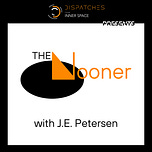This is the third post from The Nooner, a (very short) daily newsletter slash podcast that has its very own section within Dispatches from Inner Space.
To see the first post, which doubles as an explainer, click here.
Suffering is a problem.
And what a problem needs is a solution. In my own ongoing effort to find better solutions to the problem of suffering, I return very often to “the zoom out.”
Let’s start with a small enough scale for this to be easy. Like, oh, how about pushups?
If you’re going to do enough pushups for them to make any kind of difference, they’re going to hurt. And it’s not unreasonable to call this a kind of suffering.
The solution for it is simple, because it’s simple to see what the suffering is for. “No pain no gain, bro!” You’re doing exercise. Sometimes exercising sucks. But you’re doing it to get swoll, so you deal.
This is the zoom out on easy mode, because you don’t have to zoom out very far, or for very long.
Let’s try a different one.
Say you’re a young girl, severely injured by shrapnel, hiding in a burned out building until you die of thirst or infection, whichever works fastest.
Welcome to hard mode. This is the kind of thing that demands an interrogation of your cosmology, which is ultimately what dictates how your zoom outs work.
For instance, when an atheist zooms out far enough along the axes of space and time, all suffering loses its meaning. Some people find comfort in this, but it might be a hard sell for that kid, or her family.
On the other hand, a belief in a loving higher power, and the eternal nature of souls, has the potential to endow even the worst human tragedies with grace.
One good way to measure the quality of a given cosmology is by how it shapes the suffering of the countless billions throughout human history when you zoom out far enough.













Share this post